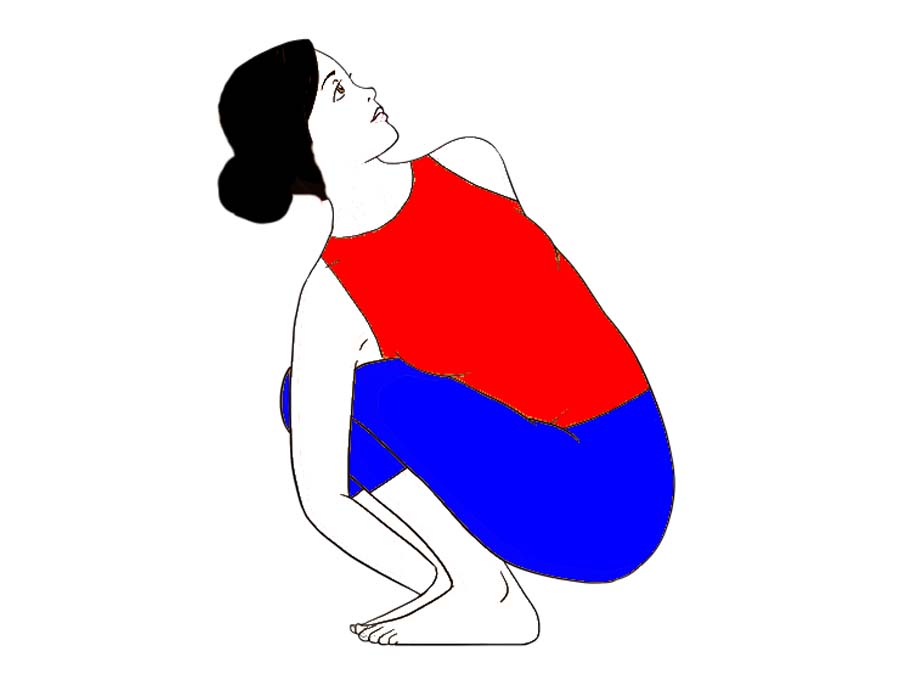Pasasana is a Sanskrit word in which “Pasa” means a tie, trap, noose, bond or cord and the meaning of Asana is a seat, pose or posture. In the Pasasana, your arms are wrapped around your squatting legs and your hands are clasped behind your back, making a noose.
Pasasana is famous for its twister pose. It is the challenging pose, and it gives your upper body very good stretch. For performing Pasasana you need to a stable and strong foundation. When you perform this Asana, your arms look like a noose. So, that’s why this Asana name so.
 Name of Asana: – Noose Pose
Name of Asana: – Noose Pose
Sanskrit Name: – Pasasana
Level of Asana: – Intermediate
Style of Asana: – Ashtanga Yoga
Navigator
Preparatory Poses
- Virasana
- Baddha Konasana
- Gomukhasana
- Balasana
- Bharadvajasana
- Supta Baddha Konasana
- Supta Padangusthasana
- Marichyasana III
- Marichyasana I
- Parivrtta Parsvakonasana
- Ardha Matsyendrasana
Follow-Up Poses
- Ardha Matsyendrasana
- Marichyasana III
Steps of Pasasana (Noose Yoga Pose)
- First, come into the Position of Palm tree Pose (Tadasana). Slowly bend your knees in a way that you are squatting on the ground. Keep your sitting bones close to your heels as your midsection (torso) relax against your thighs.
- You can also keep a folded blanket under the heels if you are uncomfortable in squatting with your flat feet on the floor.
- Now, start from your belly and bend (twist) to your right side and stretch your left arm to get its upper part to the outside of your right knee.
- After that, turn your palms down while you are bending your elbow to fold (wrap) your forearms around your right shin.
- Then, extend your right hand and turn it to your back. Then grab your left wrist with your right hand or you may also hook your fingers.
- Next, turn your head towards right along with pull shoulder blades backward in a way that they are towards to each other.
- While you are breathing, raise and extend your sternum to the top of your crown (head).
- After that, bend your body ahead as you breathe out and try to go forward with your left ribs. The last step, Remain in the posture for 20 to 30 seconds and slowly discharge the pose. Rest for a while and follow the same procedure by bending to your left.
- Hold the pose for a few seconds and release. Repeat the asana by twisting to your left (If you want to challenge yourself, then you can use you wrapped arms around your legs to pull down your top arm).
Benefits of Pasasana (Noose Yoga Pose)
Physical benefits
- Pasasana stretches and strengthens your Vertebral column, groin, Ankles.
- Your abdominal muscle gets stimulated by Pasasana and it improves your digestion.
- Regular practice of Pasasana results to relieve the strain on your shoulders, neck, and back.
- Noose Yoga Pose kicks out toxins from your body.
- It makes your nervous system healthy and calms your mind, body, and soul.
- Pasasana is the best exercise for opening up your chest, thighs, ankles, shoulders, and groin also.
Therapeutic Benefits
- Pasasana is the best workout for releasing the tension from your back, shoulder, and neck.
- Reduces the discomfort of the menstrual cycle of women.
- Beneficial for those people who are facing the issue of Asthma.
- Pasasana helps to decrease the issues belongs to flatulence and indigestion along with beneficial in sciatica.
- Noose Yoga Pose gives your abdominal region good massage; by this, your digestion is improved.
NOTE
Keep your bowels empty before practicing any Asana. You have to take a 4 to 6 hours gap between your meal and Asana. Try to perform all the yogic activities in the time of morning. If you have a hectic schedule then, you may also practice yoga season in the evening also.
Avoid this Asana, in case of back, neck, ankles your arms injury. Always prefer to perform Yogic activities in front of an expert person.
Yoga needs guidance and regular practice. So, don’t think that you got all the benefits in one day. Benefits need a correct way of practice and your dedications towards becoming healthy. Please free your mind while you are practicing any Asana or Pranayama. Keep focusing on your practice.
(Hard work is a key to success)

